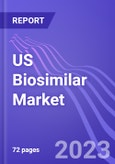This report comes with 10% free customization, enabling you to add data that meets your specific business needs.
However, the market growth is expected to be restrained by complexities in manufacturing, excess competition and complexities in pricing.
The US biosimilar market by drug class can be segmented as follows: monoclonal antibodies, filgrastim & pegfilgrastim and others. In 2023, the dominant share of the US biosimilar market was being held by monoclonal antibodies, followed by filgrastim & pegfilgrastim. As of 2023, there have been 40 biosimilars approvals since the first approval in 2015 and more than 30 launches in the U.S. biosimilar market.
The US biosimilar market by product can be categorized as follows: Prolia (Denosumab), Xolair (Omalizumab), Rituxan (Rituximab), Humira (Adalimumab) and Stelara (Ustekinumab). The US Biosimilar market landscape by class can be categorized as follows: Supportive Care, Oncology, Long Acting Insulin, Rapid Acting Insulin, Ophthalmology and TNF blockers. Factors such as patent expiry Of biologics and research on new indications has been supporting the US biosimilar market.
The COVID-19 pandemic has introduced new challenges for the pharmaceutical industry, including makers of biosimilars. The pandemic threatened to derailed product pipelines. During the height of the outbreak, resources were diverted away from the research and development of new biosimilars and towards the fight against COVID-19.
Scope of the report
- The report provides a comprehensive analysis of the US biosimilar market with impact of COVID-19.
- The major regional markets (China, Europe, North America and Rest of the world) have been analyzed.
- The market dynamics such as growth drivers, market trends and challenges are analyzed in-depth.
- The competitive landscape of the market, along with the company profiles of leading players (Pfizer Inc., Novartis AG, Amgen Inc., Samsung Biologics Co., Ltd., Celltrion, Inc. and Viatris Inc.) are also presented in detail.
Key Target Audience
- Biosimilar Companies
- Biologics Companies
- Hospitals
- Consumers
- Pharmaceutical companies
- Investment Banks
- Government Bodies & Regulating Authorities
Please note: 10% free customization equates to up to 3 hours of analyst time.
Table of Contents
Companies Mentioned
- Celltrion, Inc.
- Samsung Biologics Co., Ltd.
- Amgen Inc.
- Pfizer Inc.
- Novartis AG
- Viatris Inc.
Table Information
| Report Attribute | Details |
|---|---|
| No. of Pages | 72 |
| Published | August 2024 |
| Forecast Period | 2024 - 2028 |
| Estimated Market Value ( USD | $ 18.41 Billion |
| Forecasted Market Value ( USD | $ 71.04 Billion |
| Compound Annual Growth Rate | 40.1% |
| Regions Covered | United States |
| No. of Companies Mentioned | 6 |









